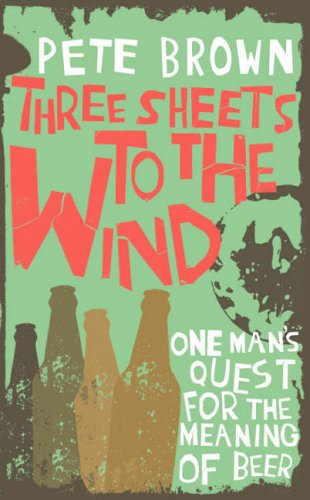
Macmillan
Soft Cover, $13.75 (10.99 £), 458 pp.
“If we’re living in a global village, where’s the pub?”
I will confess straight up to being a Pete Brown fan. (The above jacket quote alone should earn him many new fans). While my shelves groan with weighty dissections of various beer styles and bulky compendiums of brewing minutia, there are very few books exploring why we love beer. Three Sheets to the Wind, along with Pete’s A Man Walks into a Pub and Ken Wells’ Travels with Barley, are the heart of a (hopefully) expanding section of great reads on humanity’s 6,000-year love affair with beer.
Brown opens up with the ultimate call of the wild: “‘Fancy a pint?’ asks colleague Simon.” Thus begins his 400-plus-page opus on the meaning of beer to his fellow travelers on this planet. The phrase “Fancy a pint” itself is rife with social and economic significances, ranging from romantic preludes to job offers to the simple relief of tedium. His point, however, is that beer culture is in fact thick with all of this texture. That is the heart of Brown’s work—the texture society has given beer.
For page after page, the reader follows Brown around the world as he wanders, staggers and stumbles into one beer-rich circumstance after another. After all, “fancy a pint,” with its national, regional or local variations, is a universal call to comradely arms. And these wanderings down city byways—Barcelona to Prague, Milwaukee to Sydney—prove opportunities for exploration of the social mores of beer—real or feared. Take the response of a couple of Czech beer drinkers to Brown’s relaying of the English notion that drinking beer leads to fighting:
“Can you imagine trying to have a fight after twelve beers?”
“’Right you—I’m going to ******* kill you—but just wait there a minute, I have to go to the toilet again first!”
While All About Beer Magazine readers might enjoy joining Brown in his pub visits around the world, you will really revel in his portraits of American brewers. Even knowing each of the characters that populate this chapter, I found his ability to capture the essence of each subject to be uncanny. Woven behind these character studies and city profiles, Brown creates a fantastic tableau of American beer culture and history. I swear I’ll never think of Carrie Nation so one-dimensionally again.
And then there is the writing. If you are a fan of dry English wit, the humor alone is worth the price of admission to Brown’s mad boozing world. From the same culture that brought you Douglas Adams’ finest, we have sentences like this:
“The springs and cogs in my body clock have long since given up the ghost and metaphorically boinged out in a mess of analogical metal, and for whatever reason, it doesn’t feel like the end of the evening.” A tidy description of how it feels to arrive home from international travels after the bars have closed; dire straights, indeed.
The jacket brags about Brown having visited 300 different bars in 27 towns in 13 different countries and four different continents. For the club that he now, rightly, claims membership, these may be more introductory stats than pedigree-establishing numbers. But Brown has done more with them than most. He’s come to understand the true culture of beer—its benefits to civilization and the unreasonableness of the political issues posed by its detractors.
He concludes his tour de force with a commentary on the social qualities of beer. As he writes, “Beer has proved a remarkable lens through which to look at the world.” Beer drinkers are friendly. After all, we are drinking the “most sociable drink in the world.” He has found a common drinking culture across the world with similar behaviors and motivations. He closes with a discussion of the middle state, that phase in beer drinking that occurs well before the loss of a “basic level of decency and respect.” It is that place, an end in and of itself in many cultures, where beer drinkers come to experience the deep pleasure of being human and the deep bond that results from being a member of a community.










